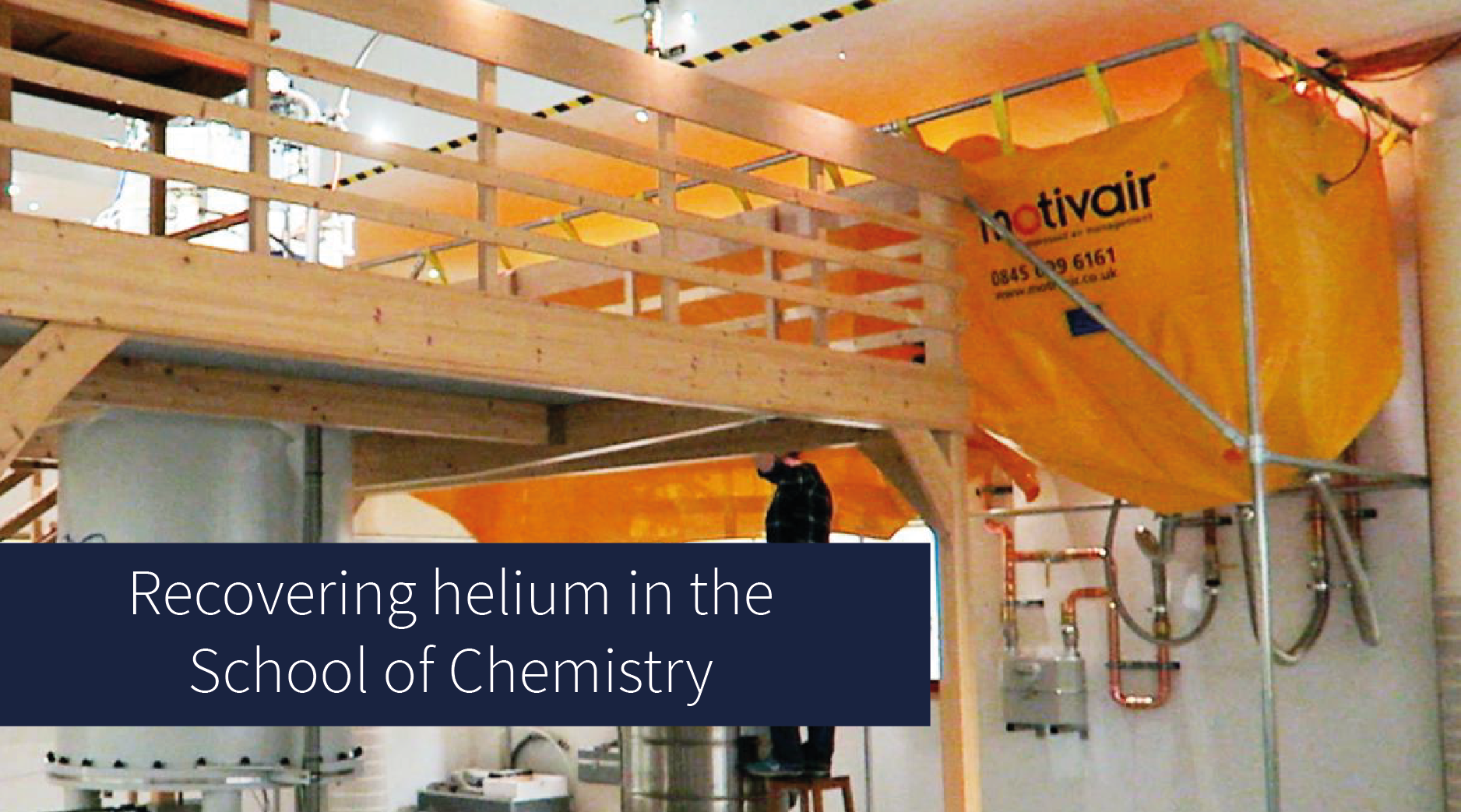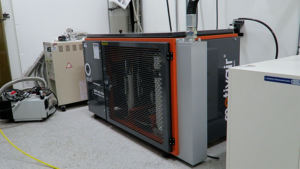Recovering helium in the School of Chemistry

Liquid helium is excellent at cooling superconducting electromagnets, but easily evaporates and escapes from equipment due to being the second smallest element. With global supplies of this non-renewable resource becoming scarce, the School of Chemistry used the Sustainable Campus Fund to invest in a novel solution to trap and collect escaping helium so it can be used again.
This blog post was first published in 2019 as a Sustainable Campus Fund case study on the Department for Social Responsibility and Sustainability website.
The importance of helium
Helium – the second lightest element – is an extremely efficient cooling agent when compressed into a liquid state.
The School of Chemistry uses large volumes of helium to cool superconducting electromagnets in its Nuclear Magnetic Resonance (NMR) instrument, used to determine and identify the structure of organic materials. The School houses the best NMR facility in Scotland and is one of the leading facilities in the UK, available for both research and industry use.
When the electromagnet is refilled with liquid helium, large amounts evaporate to gaseous form and escape due to the small size of helium molecules. Boil-off also occurs as a normal part of the instrument’s use. Both are an unavoidable part of the process, and the lightness of the element means helium passes through the atmosphere and into space, and so is lost from Earth.
A scarce resource

A helium recovery bag in the NMR Facility in the School of Chemistry
The world’s helium supply comes from a few natural gas fields in Texas, Algeria, Qatar, Russia and Australia, where helium is captured as a byproduct of natural gas extraction. As much of the helium currently extracted is eventually lost to the atmosphere, it is a non-renewable resource, and estimates suggest that global reserves will run out around 2070.
Historically, periodic shortages in supply have led to operational downtime and damage to expensive lab equipment. Helium scarcity also drives up the cost of the element, leaving buyers at the mercy of fluctuating prices.
Helium is important to both the research and medical fields and is used in MRI scanners. As there is currently no substitute for liquid helium as a super-coolant, it is important that users of helium on a large scale find ways to capture lost helium so that it can be recovered and used again.
Recovering helium in the Joseph Black building

The compressor unit
One of the projects to receive funding via the Sustainable Campus Fund was the Joseph Black Helium Recovery Scheme in the NMR Analysis Lab. Funding was used to purchase custom collection bags, copper piping and a specialised compressor, which together collect helium boil-off during the instrument’s normal operations – and crucially – during the refill process.
Helium collected in the bags is piped to a compressor which compresses it back into smaller, more manageable tanks. The compressed gas is sold back to BOC, our gas supplier, who purify it and return it back to the University.
This reduces the costs associated with purchasing helium in addition to saving this precious resource. An additional benefit of our contract with BOC is that it now includes a commitment to supply the University with liquid helium as a priority during times of national shortage.
The project was co-funded by the School of Chemistry and has an estimated payback period of 6 years.
Shortages in supply means the price of helium is steadily going up, which has a significant effect on the cost of research. The helium capture & compression equipment that we purchased using the Sustainable Campus Fund means we can recover potentially lost helium and sell it back to the supplier. This not only improves our cash flow, but – most importantly – helps to keep helium in circulation and prevent it from being lost through the atmosphere.
Juraj Bella
NMR Facility Manager
What is the Sustainable Campus Fund?
The Sustainable Campus Fund is an internal investment vehicle that finances projects within the University that will improve energy efficiency or use or produce renewable energy, as well as other types sustainability projects that generate cost and carbon savings. The fund is managed by the Department for Social Responsibility & Sustainability and delivered in partnership with the Estates Department.
Anyone at the University – staff and students – can propose projects for the fund. Once a project is proposed, we will advise and support the development of the project before submitting it to the Utilities Working Group for approval.
Can you think of a project that will help the University to save carbon and generate cost savings? Register your interest in the fund and get support to develop your idea today.





Hello,
Who would i need to get into contact with to talk about your NMR projects.
I am a University of Brighton student who is currently working a team project where we are investigating methods for reducing helium usage.
I would be interested in finding out about values for your annual cost pre and post implementation of the recapture system.
Many thanks, Corey Ede
Thanks for your interest. Someone from our team will soon be in touch.